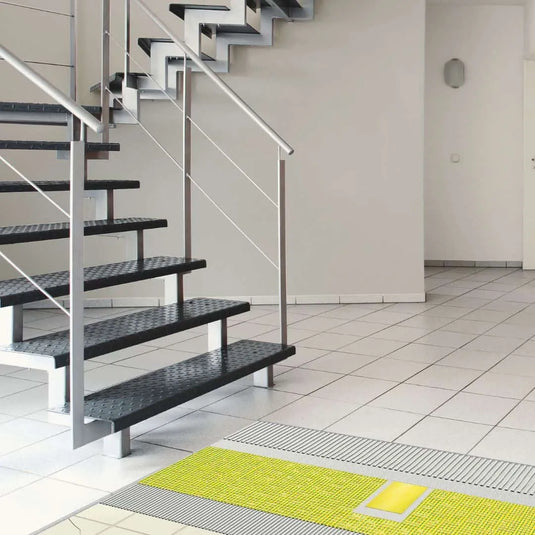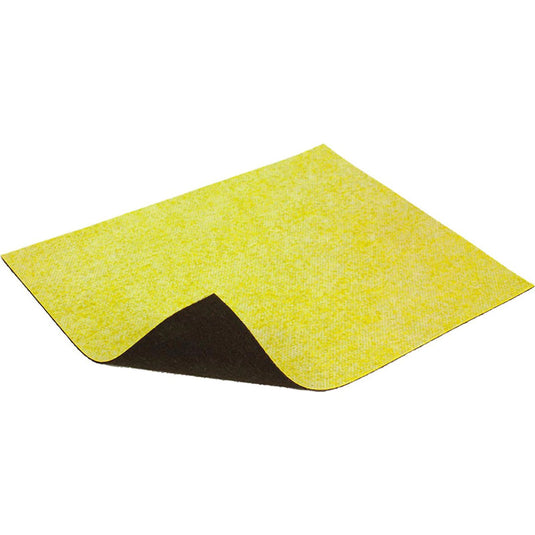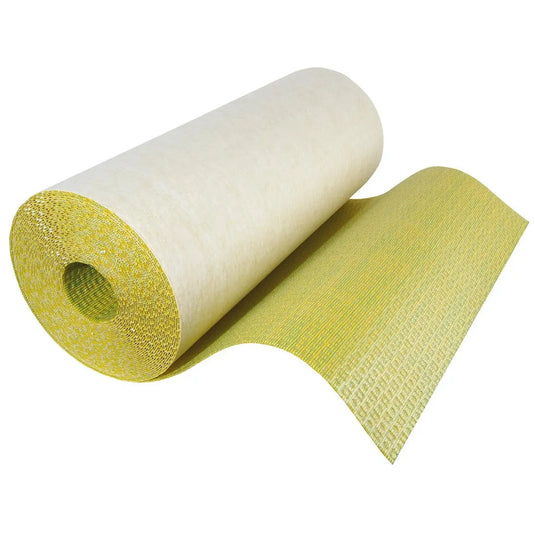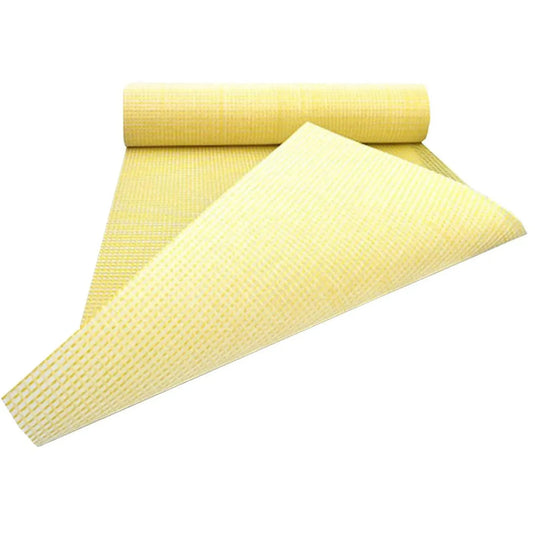Ever heard of decoupling mats? No? Then it's definitely time you did! Decoupling mats play a crucial role in construction and renovation when it comes to the durability and stability of your surfaces, whether in your cosy living room, beautifully designed outdoor area or new build. Although they are not visible at first glance, decoupling mats are the silent protectors that ensure that your floor not only looks good, but also remains stable in the long term. Let's take a look at why you definitely shouldn't do without these mats.
Why decoupling at all?
Imagine investing time and effort in laying tiles or other floor coverings. Without proper decoupling, you risk the substrate moving and unsightly cracks appearing in your floor. These cracks can not only affect the appearance of your surfaces, but also cause structural problems. A stable and reliable floor requires not only visual considerations, but above all effective decoupling to compensate for movements in the subfloor and prevent long-term damage. In this article, we take a closer look at why decoupling is a crucial factor in the durability and structure of your floor coverings.
What exactly are decoupling mats?
Decoupling mats are specially designed underlays used to lay floor coverings on uneven or unstable substrates. Made of plastic or rubber, they usually have a textured surface to ensure improved adhesion of the floor covering. The main purpose of decoupling mats is to protect the floor covering from possible damage caused by movements of the substrate.
An important area of application is the absorption and reduction of substrate movements that tend to deform, crack or break the floor covering. Especially on uneven or unstable substrates, decoupling mats act as a protective mechanism to minimise these movements and thus protect the floor covering. The use of decoupling mats is particularly advisable when laying large-format tiles, as floors can expand and contract due to temperature fluctuations. These mats compensate for the different expansions of the materials and thus prevent cracks from occurring, keeping the floor covering intact for longer.
Advantages of decoupling mats
Decoupling mats are revolutionising the construction process by making it possible to lay tiles just 3–6 days after the screed has been laid. This innovation significantly reduces construction time, enabling projects to be completed more quickly and reducing the pre-financing period, especially for rental properties. The usual drying phases are no longer necessary, allowing tradespeople to work seamlessly.
The mat effectively protects the screed from moisture damage and ensures a stable structure during the drying process. This prevents silicone joint breaks, furniture damage and unwanted deformation or cracks in the screed. Kitchen furniture remains stable and there are no unpleasant noises as the screed does not move. In addition, the decoupling mat offers added value when installing underfloor heating by compensating for any deformation and ensuring even heat distribution. It is also extremely useful when renovating old floors, especially those with cracks in the subfloor. The mat prevents cracks from transferring to the new tile covering and ensures a permanently stable foundation.
Our range of mats
Our range includes high-quality decoupling mats that have been specially developed for a wide variety of indoor and outdoor applications. Whether for renovations, new buildings or particularly demanding situations, our products offer reliable solutions for durable and stable floor installation. Discover the key features and areas of application for our tried-and-tested mat models below.
Waterproofing and decoupling membrane
Our high-performance composite waterproofing and decoupling mat is specially designed for ceramic and natural stone floor coverings in indoor and outdoor areas. This mat offers an ideal solution for renovating old surfaces with cracks in the substrate. Tile or natural stone coverings are not waterproof themselves, and laying new coverings in a moisture-proof manner would be problematic without appropriate measures. Our advanced composite sealing and decoupling system has been developed to successfully meet these challenges.
The special three-layer structure combines waterproofing with outstanding crack-bridging properties. Thanks to these features, the waterproofing mat is even approved for use indoors in areas with high moisture exposure. The areas of application extend to directly and indirectly stressed surfaces in public and private areas. This waterproofing mat has proven particularly effective in rooms where service water and cleaning water are regularly used, such as swimming pool surrounds and shower facilities.
In outdoor areas, it meets the strict requirements of stress class B0, which allows it to be used on directly and indirectly stressed surfaces such as balconies and terraces (not above used rooms). The mat has also been tested as a waterproofing membrane in combination with tile and slab coverings for building waterproofing against non-pressurised water, especially in heavily used areas such as wet rooms in public and commercial areas.
With our waterproofing and decoupling membrane, we offer an innovative solution for a wide range of applications that meets the highest standards in terms of watertightness and decoupling.
DURAL decoupling mat CI++
The DURAL decoupling mat durabase ci++ is a versatile solution that goes far beyond conventional decoupling functions. With a three-layer structure, this roll mat offers several advantages, especially when laying tiles on damaged but still load-bearing old coverings. Its crack-bridging capability and optimised shear force protection enable safe installation, even on freshly laid screed from the moment it is ready for use. The quick and easy processing of the roll mat ensures maximum installation safety.
The three-layer structure comprises:
- Interwoven special polypropylene underlay for greater underlay stability and better adhesion to the installation surface.
- Optimised stud geometry that reduces adhesive consumption.
- Coextruded mesh fabric for optimum adhesive tensile strength.
Our DURAL CI++ decoupling mat not only serves as a decoupling mat, but also as a stress-relieving intermediate layer and crack bridging. This mat enables vapour pressure equalisation in the event of moisture from behind and decouples the covering from the substrate. Small cracks in the substrate are bridged without being transferred to the tile covering. This makes DURABASE CI++ particularly suitable for renovation projects. The decoupling mat allows tiles to be laid on screeds as soon as they are sufficiently walkable (residual moisture approx. 4%). It also protects moisture-sensitive calcium sulphate screeds from further moisture penetration on the surface. When using large-format tiles, DURABASE CI++ offers additional protection against stress cracks. Technical information is included in the attached PDF data sheet.
The DURAL decoupling mat is available in lengths of 5 m, 10 m and 30 m. The grey decoupling mat is only available in 30 m lengths.
FGT reinforcement mesh
The DURAL reinforcing tile membrane is an indispensable element in renovation work, especially when substrates are not sufficiently stable due to lack of stability and damage. Often, one is faced with the challenge of insufficient installation height and must deal with complex renovation methods.
This versatile reinforcement mat is suitable for a wide range of floor coverings, including tiles, laminate, vinyl, carpet, wooden floorboards and fitted carpets (PVC floor coverings, garage floors). Thanks to its material selection, the mat is extremely strong and at the same time ensures flexible compensation for any stresses that occur. Its impressive technical properties are evident in its material thickness of only 1.5 mm, which can absorb loads of up to 1.58 tonnes and transfer them to the substrate without cracking.
The mat can be used on a variety of surfaces, including:
- Installation on old tile coverings
- Installation on OSB boards
- Installation on cracked screed
- Laying on vinyl floors
- Laying on wooden floors
- Laying on old cracked tiles
- Laying on Rigibs on the wall
With impressive point load capacity, the reinforcement mat can permanently compensate for vertical stresses between the substrate and the covering. The flexural strength of 400,000 cycles at a deflection of 1.8 mm and an adhesive tensile strength of 1.1 N/mm² guarantee a lasting bond between the substrate and the covering. All values were determined by tests carried out by an independent German institute. Simple, quick and material-saving installation makes this mesh a fundamental component for all types of durable floor coverings.
The reinforcement mat can stabilise substrates that do not originally have their own strength. It offers a secure solution for various types of flooring, from large-format tiles and carpets to modern designer flooring and natural stone flooring.
Installation instructions for our decoupling mats
- Preparation of the substrate:
- The substrate must be dry, free of any substances that could impair adhesion, stable and level.
- Any levelling work must be carried out before laying the decoupling mat.
- Applying thin-bed mortar:
- Apply thin-bed mortar to the properly prepared substrate using a notched trowel (4x4 mm).
- Use hydraulically setting flexible mortar or fast-setting flexible adhesive in accordance with DIN EN 12004 / C2.
- Important: Do not use larger notched trowels, as this will impair the decoupling effect of the mat.
- Embedding the decoupling mat:
- Embed the cut-to-size strips with the backing fleece into the adhesive over the entire surface.
- The decoupling mat must not be clamped in place.
- The strip is worked in using a pressure roller or another suitable tool.
- Treatment of mat joints and corners:
- Mat joints can be covered with sealing tape.
- Pre-formed moulded parts should be used for internal and external corners.
- Expansion joints must be made watertight using sealing tape in a loop shape.
- Tile laying indoors and outdoors:
- Indoors, the tiles can be laid using the thin-bed method immediately after bonding the decoupling mat.
- It is advisable to fill the mat recesses in one step and then comb on the thin-bed mortar with a notched trowel.
- For outdoor coverings, tile laying should only begin after the filling has hardened.
Conclusion
Overall, the use of decoupling mats is a preventive measure to avoid potential damage and ensure that floor coverings not only remain attractive but are also structurally stable. Investing in these mats pays off in the long term by ensuring the durability and resilience of floor coverings both indoors and outdoors.








